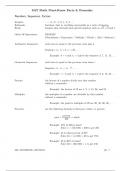SAT Math Must-Know Facts & Formulas
Numbers, Sequences, Factors
Integers: . . . , -3, -2, -1, 0, 1, 2, 3, . . .
Rationals: fractions, that is, anything expressable as a ratio of √
integers
√
Reals: integers plus rationals plus special numbers such as 2, 3 and π
Order Of Operations: PEMDAS
(Parentheses / Exponents / Multiply / Divide / Add / Subtract)
Arithmetic Sequences: each term is equal to the previous term plus d
Sequence: t1 , t1 + d, t1 + 2d, . . .
Example: d = 4 and t1 = 3 gives the sequence 3, 7, 11, 15, . . .
Geometric Sequences: each term is equal to the previous term times r
Sequence: t1 , t1 · r, t1 · r 2 , . . .
Example: r = 2 and t1 = 3 gives the sequence 3, 6, 12, 24, . . .
Factors: the factors of a number divide into that number
without a remainder
Example: the factors of 52 are 1, 2, 4, 13, 26, and 52
Multiples: the multiples of a number are divisible by that number
without a remainder
Example: the positive multiples of 20 are 20, 40, 60, 80, . . .
Percents: use the following formula to find part, whole, or percent
percent
part = × whole
100
Example: 75% of 300 is what?
Solve x = (75/100) × 300 to get 225
Example: 45 is what percent of 60?
Solve 45 = (x/100) × 60 to get 75%
Example: 30 is 20% of what?
Solve 30 = (20/100) × x to get 150
www.erikthered.com/tutor pg. 1
, SAT Math Must-Know Facts & Formulas
Averages, Counting, Statistics, Probability
sum of terms
average =
number of terms
total distance
average speed =
total time
sum = average × (number of terms)
mode = value in the list that appears most often
median = middle value in the list (which must be sorted)
Example: median of {3, 10, 9, 27, 50} = 10
Example: median of {3, 9, 10, 27} = (9 + 10)/2 = 9.5
Fundamental Counting Principle:
If an event can happen in N ways, and another, independent event
can happen in M ways, then both events together can happen in
N × M ways.
Probability:
number of desired outcomes
probability =
number of total outcomes
Example: each SAT math multiple choice question has
five possible answers, one of which is the correct answer.
If you guess the answer to a question completely at ran-
dom, your probability of getting it right is 1/5 = 20%.
The probability of two different events A and B both happening is
P (A and B) = P (A) · P (B), as long as the events are independent
(not mutually exclusive).
Powers, Exponents, Roots
xa · xb = xa+b xa /xb = xa−b 1/xb = x−b
(xa )b = xa·b (xy)a = xa · y a
�
n +1, if n is even;
√ √ √ (−1) =
0
x =1 xy = x · y −1, if n is odd.
www.erikthered.com/tutor pg. 2




